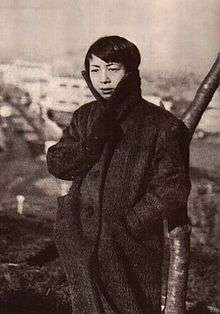Yasuko Harada
Yasuko Harada (原田康子) (January 12, 1928 – October 20, 2009) was a Japanese novelist.
Yasuko Harada | |
|---|---|
原田康子 | |
 | |
| Pronunciation | ja |
| Born | January 12, 1928 Tokyo |
| Died | October 20, 2009 Sapporo |
| Nationality | Japanese |
| Occupation | Novelist |
Notable work | Sabita no kioku (1954); Banka (1956) |
Early life and education
Harada was born on January 12, 1928 in Tokyo. She and her family moved to Kushiro, Hokkaido when she was a year old for her father's job.[1] After getting tuberculosis as a child, she had lots of health problems, including nephritis.[2] She read a lot while she was ill in bed, especially fairy tales from foreign countries. She began writing her own fairy tales during World War II. Toward the end of the war she had to work in a factory as part of the National Mobilization Law. She hated it. After the war, Harada worked as a reporter for the Kushiro newspaper. She married Yoshio Sasaki in 1951.[2]
Career
Harada's first books were serialized in magazines while she worked as a reporter. Her first published story, "Fuyu no ame", was published in 1949 in the Hokkaido Bungaku magazine.[3] In 1954, her short story "Sabita no kioku" was praised by Shinchō as one of the best short stories of the year, but ultimately did not win their literary prize. Her novel Banka (novel) won a Women's Literature Prize, and was her only bestseller. It was made into a film that was directed by Heinosuke Gosho.[2] Her 1999 novel, Wax Tears (蝋涙) also won the Women's Literature Prize. Her 2003 book, Kaimu (海霧), won the Yoshikawa Eiji Award[1]
Style
Harada's works were popular with young women in their twenties and thirties.[2] Harada's books are usually about sensitive young women who suffer from various ailments. Her protagonists often long for the kind of love where they can feel protected and understood, but still have freedom and self-determination. Many of her books take place in her native Hokkaido.[5]
Harada's style has been compared to Francois Sagan, but though she has more courage when writing difficult scenes, he has a better way with words.[6]
Selected bibliography
Short stories
- Fuyu no ame (冬の雨), 1949
- Sabita no kioku (サビタの記憶), 1954
- Yuki no su (雪の巣), 1954
Novels
- Banka (挽歌), 1956
- Itazura (いたずら), 1960
- Yameru oka (病める丘), 1960
- Satsujinsha (殺人者), 1962
- Kita no hayashi (北の林), 1968
- Niji (虹), 1975
- Nichiyobi no shiroi kumo (日曜日の白い雲), 1979
- Kaze no toride (風の砦), 1983
- Kaimu (海霧), 2003
References
- "原田康子 | 著者プロフィール | 新潮社". www.shinchosha.co.jp (in Japanese). Retrieved 2019-11-23.
- Japanese women writers : a bio-critical sourcebook. Mulhern, Chieko Irie. Westport, Conn.: Greenwood Press. 1994. ISBN 0-313-25486-9. OCLC 29848281.CS1 maint: others (link)
- "原田康子". www.asahi-net.or.jp. Retrieved 2019-11-23.
- "作家の原田康子さん死去 小説「挽歌」「海霧」など". 47 news. October 21, 2009. Archived from the original on October 24, 2009. Retrieved November 22, 2019.
- Schierbeck, Sachiko Shibata. (1994). Japanese women novelists in the 20th century : 104 biographies, 1900-1993. Edelstein, Marlene R. [Copenhagen]: Museum Tusculanum Press. ISBN 87-7289-268-4. OCLC 32348453.
- Janeira, Armando Martins (2016-08-09). Japanese and Western Literature: A Comparative Study. Tuttle Publishing. ISBN 978-1-4629-1213-1.